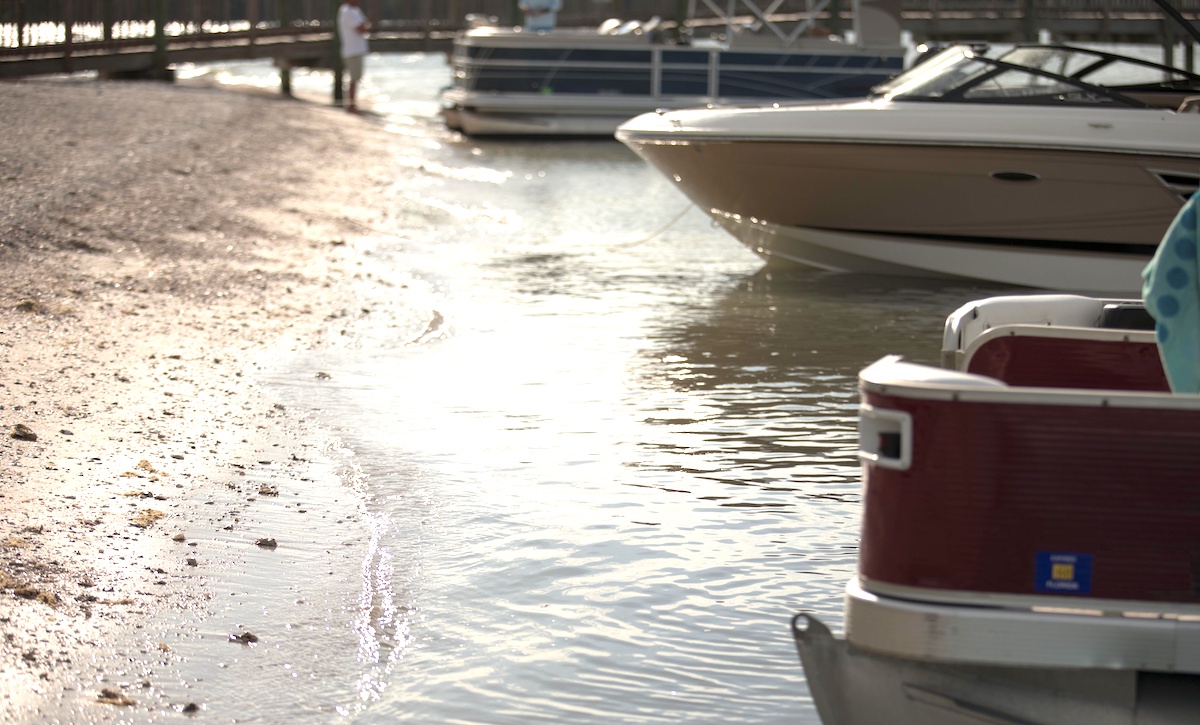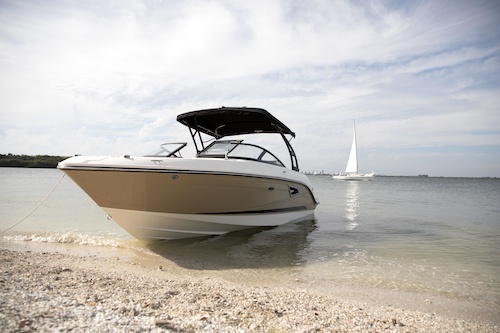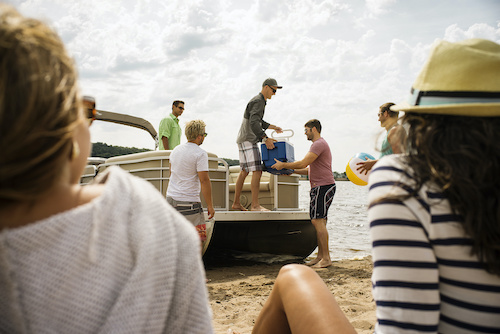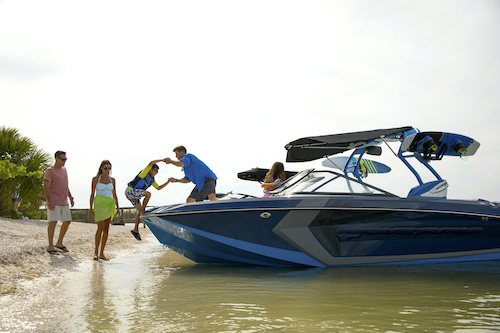Simply being on a boat is fun, but where boats can take us to play is even more exciting and often the whole point of boating. Recreating near beaches and sandbars to camp, raft up, or give the kids a place to run and play in shallow water is a great way to enjoy a sunny day—but, while we swim, build sandcastles and picnic on shore, we still have to keep an eye on the boat.
Whether you’re cruising on a pontoon and spot an inviting cove, or you’re running the buoys of a slalom course on your ski boat and want to take a break on shore, beaching a boat is a quick way to land and relax for a few hours.
Here are the basic steps to a safely and successfully beach a boat—and then eventually, unbeach your boat and head home.
Beaching a Boat: Step-by-Step Guide
- Examine the shoreline. How deep is the water and how quickly does it shoal? Is there a straightforward path of approach with no obstacles; this includes swimmers and snorkelers?
- Approach slowly. Never throttle hard to get the boat up onto the beach even if you know the area.
- Judge the water depth. If you have a depth sounder, keep an eye on it and know your draft (see What is Boat Draft? to learn more). If you don’t have sounder, estimate what is about waist-deep water. Watch for current, especially in a river or breaking waves on the ocean because both will mess with your landing.
- Have a crew member hop in and hold the bow of the boat when waist deep.
- Turn off and trim up your engine (outboard or sterndrive). Pull the boat ashore bow first—this may take more than one person.
- Always secure your boat. You can do this by walking an anchor up the beach, tying off to a stake or securing to a nearby tree.
- Remember, the back of the boat will be heavier due to the weight of the engine, so make sure that you don’t pull the keel all the way up or it will be tough to leave.
- Pull the boat further up once gear and passengers are unloaded; it will be lighter and can be dragged farther up.
- When it’s time to leave, pull the boat free of the shore until it’s floating.
- Finally, load up and lower the engine or drive in waist-deep water, have the last of the crew hop aboard via the swim ladder and back away from shore.
7 Tips for Boating in Shallow Water
Anchoring Near a Sandbar or Beach
Depending on the location, sometimes it’s safer to “beach anchor” with the boat in shallow water, but not actually touching the sandbar or beach. This generally faces the bow out to open water, ensuring the boat is facing any waves that could swamp it.
There are a number of techniques to accomplish this, but the basics are similar and are easier when there is crew to assist. Be sure to have two anchors, or at least an anchor and a line ready to use before starting (see Types of Anchors: How to Choose the Right Size Anchor to ensure you have the right equipment before you get started).
- Approach in idle. The boat should always remain floating so watch your depth sounder if you have one.
- Run the bow anchor and line aft to a crew member who will place it in the water and let out the line. They need to keep it away from the propeller as you motor forward toward the beach.
- When you’re in the desired location and depth, tie up the line so the anchor is set and cleat it off.
- When in waist deep water, have the crew member place the stern anchor into the water on the opposite side where the bow line is. This will keep the lines from tangling and will help the boat to rotate easier.
- Allow the boat to pivot so it’s facing away from the sandbar. Turn off and trim up the engine or drive.
- The rest of the passengers onboard can also jump in and take the stern anchor up the beach. Unload the boat of people and gear while in shallow water.
- Tie up both the bow and stern lines, which will pull the boat out a little deeper, and it will float rather than rub on the beach. Both lines should be pulled tight so the boat stays in place.
- To depart, board the boat and let out some forward anchor line.
- Have crew pull the boat back a bit, load everyone and everything, and then lift the stern anchor or untie the stern line.
- Pull the boat forward on the bow anchor line, lower the engine or drive, start the engine, lift the anchor and leave.
How to Anchor a Boat in Deep Water
Other Factors to Consider When Beaching a Boat
Bottom Conditions
You must know the bottom conditions before approaching any beach. Are there rocks, gravel, branches or obstacles that could damage the bottom or the propeller? Sand is abrasive and can damage the gelcoat finish on a hull, while rocks pose a real threat to both the boat and the engine.
If sand gets into a jet drive, it can also wreak havoc with the engine. If the beach is sandy but there’s mud below the water, the suction it creates can get a boat stuck fast.
Keep an Eye on the Tides
Understand the tides. If the tide goes out, will you be able to pull the boat back into the water? If the tide comes in, will your boat float away? Check the boat every hour or so to ensure it’s not burrowing into the sand.
Pay Attention to the Wind
Keep an eye on changing wind conditions including strength and direction. The wind can push the boat up the beach or back into deeper water when you’re not watching.
If a storm is approaching, you can either decide to depart quickly or stay and secure everything (see Weather Safety Tips for Boaters). A boat will be safer at anchor during a storm rather than being pummeled on the beach. Passing boats can even swamp a boat that has its stern turned out to the water.
Beaching a Boat Overnight
All of the above points really come into play when beaching overnight to camp for example. Before you tuck in for the night, take all of the above into consideration, slow down and pay attention to details so you can just push off, start the engine and be on your way in the morning.
Read Next: 5 Tips for Sleeping On Your Boat Overnight
You May Also Like:



